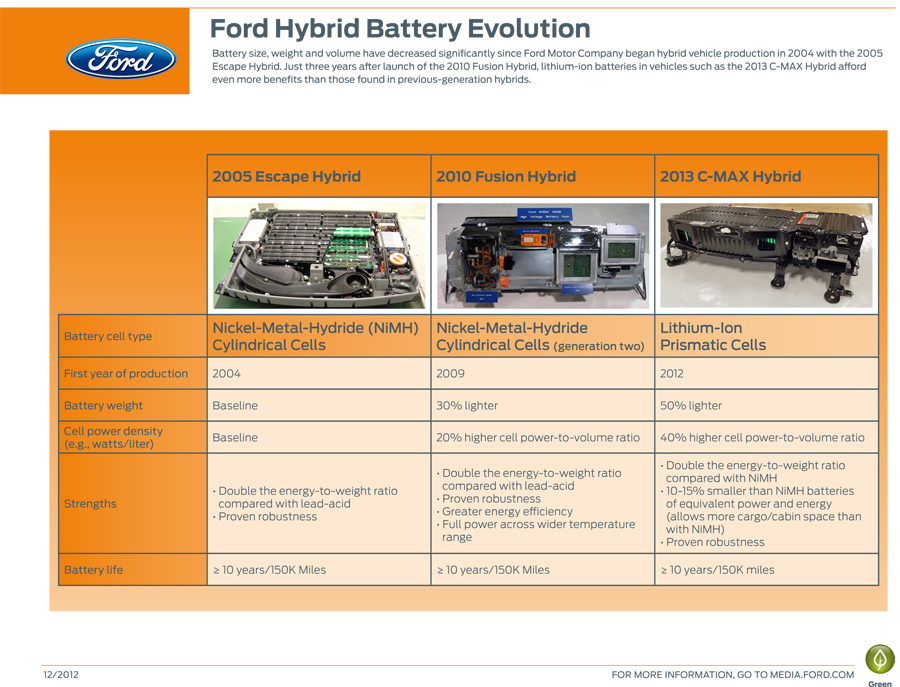Ford Lab Simulates 10-year Battery Use in Sub-one-year
2013/04/10 | By Quincy LiangWith advanced test-simulation technologies, American automaker Ford Motor Co. is putting the equivalent of 10 years and 150,000 miles of wear and tear on hybrid vehicle batteries using a new lab test that takes less than a year to complete.
According to Ford, it designed a new test tehnique– the Key Life Test – specifically for its new lithium-ion (li-ion) batteries, drawing on more than 20 years of extensive data and experience to deliver reliable hybrid vehicles today.
The test allows engineers to simulate in a lab setting many factors, including location of a battery within a vehicle, the temperatures they might have to endure, and various kinds of acceleration and stopping that different drivers would apply. The scope of the testing also includes the ability to put 150,000 miles (the equivalent of about 10 years of average use) on the test batteries in about 10 months.
The Key Life Test aims to deliver higher-quality and even more reliable batteries, said Kevin Layden, director of Ford Electrification Programs.
According to a recent Ford-commissioned survey, in fact, battery reliability ranks as the most important purchase consideration by potential hybrid-vehicle customers by topping 17 other factors such as fuel economy and number of safety features.
Layden pointed out that recent studies show consumers are keeping their vehicles longer, and regulations in some regions now require batteries to carry warranties for greater distances. “Fortunately, our tests take into account distances and conditions that go way beyond those normal requirements,” the director added.

More EV Models in 2013
Ford said that it would offer five electrified vehicles by 2013 – all equipped with advanced li-ion batteries. All the company's previous-generation vehicles lineup featured nickel-metal-hydride (NiMH) batteries. However, Ford said, Li-ion batteries offer numerous benefits, including a size 25% to 30% smaller, and the ability to provide about three times the amount of power per cell than the previous state-of-the-art NiMH battery technology.
Other battery tests include simulating hot and sunny weather by subjecting batteries to greater than 140-degree Fahrenheit (60-dgree Celsius) temperatures, extreme cold conditions with frigid -40-degree Fahrenheit (-40-degree Celsius) tests, and by driving vehicles equipped with the batteries through ditches filled with water to ensure there are no issues.
Ford's experience with hybrid vehicle technology dates back to the late 1980s. The technology evolved quickly, resulting in limited release of the Ranger EV in 1998, the Escape Hybrid in 2004 and the Fusion Hybrid in 2009. Ford draws on these vast amounts of data it collected from previous-generation hybrids.
For example, 50 million battery cells have been produced since 2004 in previous-generation production Ford hybrid vehicles such as the Escape Hybrid and Fusion Hybrid. Some of these have been put to use in taxi fleets in such cities as San Francisco and New York, with some taxi vehicles attaining more than 250,000 miles individually and taxi fleets in California alone attaining a total of nearly 100 million miles, Ford said.
Ford claimed that the success rate is stellar: Of all Ford production hybrid vehicles produced to date, only six battery cells have failed of the 50 million that were put into use.
“We can't do an apples-to-apples comparison between the nickel-metal-hydride and lithium-ion batteries,” said Mazen Hammoud, chief engineer, Electrified Powertrain Systems at Ford. “But we can evaluate much of the data collected to see how hybrid vehicles are driven, the kinds of conditions they face and the demands that are placed on them. Knowing all of that helps us benchmark our tests and ensure the lithium-ion batteries are meeting or exceeding expectations.”
Going further
The Key Life Test represents just one aspect of Ford's commitment to deliver fuel-economy across its lineup and triple electrified vehicle production capacity by 2013, the automaker said.
Ford is investing US$135 million in the design, engineering and production of key components – including doubling its battery testing capabilities – for the five electrified vehicles the company will have in its portfolio by the end of 2012: Fusion Hybrid, Fusion Energi plug-in hybrid, C-MAX Hybrid, C-MAX Energi plug-in hybrid and Focus Electric.
Ford also now has more than 1,000 engineers working on vehicle electrification, which is headquartered at its 285,000-square-foot Advanced Electrification Center in Dearborn.
The American automaker claimed that the investment in people and infrastructure is already paying off: Ford has reduced the cost of its current hybrid system by 30% compared with previous-generation technology and vehicles are coming to market 25% faster.




